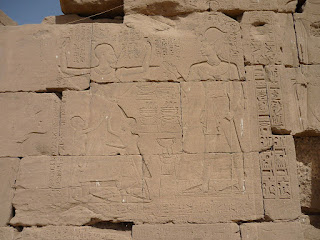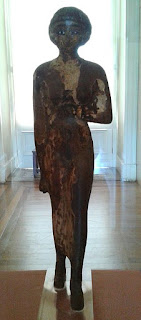Statue of the High Priest of Amun Haremakhet, son of pharaoh Shabaka. Reign of Tanutamani, late 25th Dynasty, Third Intermediate Period. Found in Karnak cachette, formerly in Cairo Museum (CG 42204 / JE 38580), now in the Nubian Museum of Aswan.
lunes, 31 de enero de 2022
Sitting statue of the High Priest of Amun Ramessesnakht
Sitting statue of the High Priest of Amun Ramessesnakht as a scribe with a baboon on the shoulders, dedicated by his son Esamun. Granite, found at Karnak in the great temple cachette. Reign of Ramesses IV, 20th dynasty, New Kingdom. Cairo, Egyptian Museum CG 42162 (JE 36582).
public domain
statue of Ramessesnakht,
A view of the left side of the statue of Ramessesnakht, the High Priest of Amun at Thebes under Ramesses IV, 20th Dynasty. This is a schist, statue with a calcite base. It depicts the Triad = Amun & Mut as parents, Khonsu as son (note K's side-braid). Its catalogue number is Egyptian Museum CG 42163. Ramessesnakht served as High Priest of Amun from the reigns of Ramesses IV until that of Ramesses IX.
public domain
Two ushabti of Bakenkhonsu
Two ushabti of Bakenkhonsu, High Priest of Amun in Thebes during the reign of Ramesses II. Painted wood from el-Assassif, near King's Valley, Thebes; 19th dynasty (reign of Ramesses II), New Kingdom. Archeological Museum of Bologna
public domain
Amenhotep, high priest of Amun, and Ramses IX -
Amenhotep, high priest of Amun, and Ramses IX - Wall relief on second axis, Karnak temple of Amun-Ra, Egypt
public domain
Statue du vizir Psammétikseneb
Statue du vizir Psammétikseneb présentant un naos du dieu taureau Mnévis. Le vizir porte au cou un pendentif représentant la déesse Maât, déesse de la justice. Règne de Nectanébo II - XXXe dynastie égyptienne - Musée du Louvre
public domain
domingo, 30 de enero de 2022
Book of the Dead of the Goldworker of Amun, Sobekmose,
Book of the Dead of the Goldworker of Amun, Sobekmose, ca. 1500-1480 B.C.E. Papyrus, ink, pigment, 14 x 293 in. (35.6 x 744.2 cm). Brooklyn Museum, Charles Edwin Wilbour Fund, 37.1777E (Photo: Brooklyn Museum, CONS.37.1777Ec_2010_at_uv_view2.jpg)
https://www.brooklynmuseum.org/opencollection/objects/118297
Thomas Young
Muy conocido por sus investigaciones y por las numerosas conferencias que realizó como profesor de la Royal Institution.
Young intentó descifrar los jeroglíficos de la piedra Rosseta. En 1818 se publicaron sus conclusiones sobre la traducción en la enciclopedia Británica, aunque después fue Champollion quien realizó la traducción más completa.
Wooden stela
Wooden stela
In this round-topped stela, painted on one side only, the single scene lies above six horizontal lines of text. A 'Kheker'-frieze divides the inscription from the writing. In the arch is a 'pt'-sign, on which are painted stars and below this is a winged sun-disk. Below these is a solar-bark in which are seated the deities Re-Harakhty, Isis, Nephthys and Atum. Their names are painted above them in a cursive script and they all have the Maat-feather on their knees.
The main text reads from right to left and consists of the htp-dj-nsw formula, written in cursive script and unfortunately damaged in places. The outer border of the stela is made up of blocks of red, blue, pink and green, the colours are still quite bright.
22ND DYNASTY
ATUM, RE-HARAKHTY , ISIS ,NEPHTHYS
FORMULA Htp-di-nsw.t
Originally in the private collection belonging to Joseph Mayer, which was given to the Museum in 1867. See for more information object M13519, Object's History.
Inventory number M11068
LIVERPOOL MUSEUM
http://www.globalegyptianmuseum.org/record.aspx?id=4264
Statue of an official named Horemheb
Statue of an official named Horemheb. Ptolemaic Period, from Naukratis. In Cairo, Egyptian Museum, Ground floor, gallery 49, CG 1230.
public domain
Tiny head from a bronze statuette of pharaoh Shebitqo
Tiny head from a bronze statuette of pharaoh Shebitqo of the 25th Dynasty. The twin-cobra diadem is barely visible. Museo Egizio, Turin, C.1394.
public domain
Woman standing with headdress and dress
Woman standing with headdress and dress
Musee de Boulaq - This image comes from the Travelers in the Middle East Archive (TIMEA) where it is available at the following Uniform Resource Identifier: 7052. Original source: Original card: "[Musee de Boulaq]." (Musee de Boulaq). 5"x 3.25". From the collection of Dr. Paula Sanders, Rice University. This tag does not indicate the copyright status of the attached work. A normal copyright tag is still required. All of TIMEA's content is licensed under a CC-BY-2.5 license. Depending on their publication date, some images might be in the public domain.
Sphinx colossal de Psammétique II
Sphinx colossal de Psammétique II provenant d'Héliopolis et retrouvé à Alexandrie - XXVIe dynastie égyptienne
public domain
Bust of a unnamed ancient egyptian dignitary
Bust of a unnamed ancient egyptian dignitary, wearing a smooth wig and a large necklace. His gaze is turned slightly upward in an attitude that has been called "'ecstasy of the apotheosis". Black granite (H. cm 26), unknown provenience, probably datable to the end of the reign of Psamtik I (before 610 BCE), 26th dynasty, Late period. Archeological Museum of Bologna (Italy), gift by the Fondazione della Banca del Monte (1994), EG 3322.
public domain
viernes, 28 de enero de 2022
Statuette naophore d'un dignitaire de l'époque saïte
Statuette naophore d'un dignitaire de l'époque saïte présentant le dieu Osiris-Hemag dans son naos - XXVIe dynastie égyptienne - Musée du Louvre
public domanKneeling-praying statue of an high ancient Egyptian official, Nekao.
Kneeling-praying statue of an high ancient Egyptian official, Nekao. The remarkable workmanship of the legs contrasts with that of the poorly carved hands. Basalt from Sais (probably from the temple of Neith), beginning of the 27th dynasty, Late period. Archeological Museum of Bologna (Italy), Palagi coll. KS 1838.
public domain
Knneling figure of Sobekhotep V
Knneling figure of Sobekhotep V with ointment vessels; ca. 1725 BC; Neues Museum Berlin, Germany; ÄM 10645


































